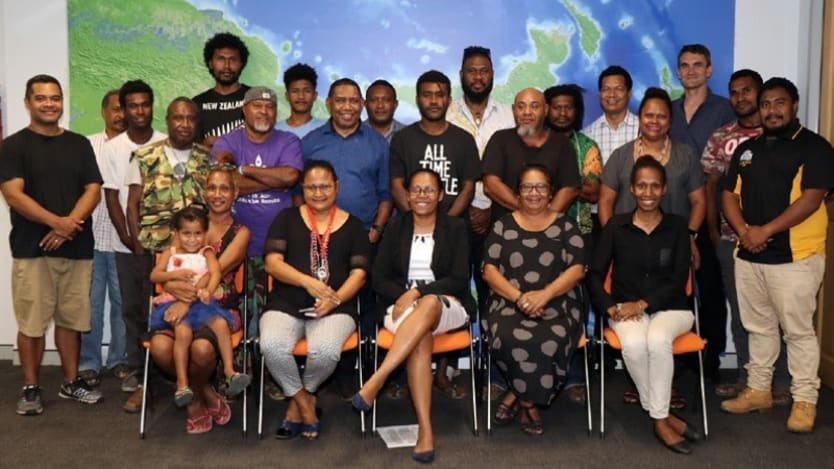
CANBERRA — In Papua New Guinea, creative industries play an important role in the culture and heritage of the nation. They also present an opening to build economic opportunities through the unique offerings of artists, musicians, designers, and performers. But as with many other countries, such opportunities are limited by the infringement of intellectual property — and a lack of formal knowledge about what intellectual property is.
Australia’s Department of Foreign Affairs and Trade has engaged an Indigenous supplier, Ninti One, to tackle this challenge. A new aid project, “Intellectual Property in PNG’s Creative and Cultural Industries,” is being supported by a three-person team of Australian experts — an Indigenous Australian artist and curator, an IP legal expert, and an art economist — applying their local experience in an international landscape.
“If you have an issue, you want to make change, or you want to access philanthropy, 100 individual voices are never going to get a hearing, whereas one collective voice has a stronger negotiating position.”
— Tim Acker, principal researcher, Ninti OneThe initial findings show that building knowledge of IP rights and how to protect them is critical in advancing opportunities for these creative sectors.
More on DFAT:
► Australian NGOs give their recommendations for DFAT aid review
“People we spoke with were more likely to have heard something about copyright along the way, and a lot of people we spoke to had experiences of their copyright or intellectual property being infringed in some way,” Tim Acker, an art economy expert with Ninti One and member of the IP aid project team, told Devex. “But that was where it stopped — they didn't know what to do when it had been infringed.”
Surveying the PNG landscape
In November, the IP aid project team met with more than 60 people — collectively representing a wide range of PNG’s creative and cultural industries and hailing from various parts of the country — to understand the challenges and potential solutions.
“Over a week, we met with various sectors — fashion in the morning and visual artists in the afternoon and so on,” Acker said. “The aim was to talk to all sorts of people in the supply chain representing the different sectors in the creative industries.”
The consistent challenge identified was the lack of IP knowledge. When it came to other areas of intellectual property — including moral, performance, and mechanical rights — there was very little understanding, which had led to “some pretty scary” IP infringement stories, according to Acker.
“There were stories of people who didn't either know or it wasn't documented, the legal and bureaucratic systems being too slow and dysfunctional that complaints essentially disappeared into the ether,” he said.
Developing a road map for action
In meeting with these industries as well as gaining an understanding of the legal and institutional structures supporting IP, a road map was developed to help the PNG government and its creative sectors take action to protect IP rights and enforce them. The road map is set to be presented and finalized in March.
“One of the things we've built into the road map strongly is the need for greater industry lead voices,” Acker said. “That is the idea of peak bodies or advocacy groups that are generated by the sector themselves. Waiting for the intellectual property organization or government to make change is not going to happen.”
The creation of an industry-led body is a key recommendation from the project, and the team has suggested that its importance needs to be “pushed up the scale a little bit.”
“We heard from several people — if you have an issue, you want to make change, or you want to access philanthropy, 100 individual voices are never going to get a hearing, whereas one collective voice has a stronger negotiating position,” Acker said.
This is one of three major findings influencing the team’s recommendations, which also include changes to legal and institutional practices that can limit or prevent the protection of IP.
Creating accessible information that people can download for free, piloting Indigenous communal intellectual property programs in select regions of PNG, and establishing a cultural adviser position within the country’s national museum are among the recommendations proposed by the Ninti One team in its road map to help the cultural industries grow — and strengthen resilience and capacity in flexing their IP rights.
Why does this project matter to DFAT?
Acker said that for the Australian aid department, this program — despite being small in scale — is particularly topical now and fits within an economic governance and Pacific agenda.
“This is one part of a bigger project that Abt [is] rolling out on behalf of the high commissioner of the Australian government with PNG,” he said. “The issue of intellectual property matters in emerging economies where there is a very strong tribal and geographically dispersed population that see technology changes distribution and access to information and knowledge.”
It is not only the limited understanding of IP rights that presents a challenge — infringements disincentivize creativity and economic opportunities in countries such as PNG.
“People may make something and it gets ripped off,” Acker said. “Multiply that across the country of PNG and you suddenly get a handbrake on people’s inventiveness and creative thinking.”
But the project has the potential to make a wider impact on Australia’s aid programming — and on IP rights more broadly.
“This work definitely applies in other places across the Pacific and other emerging economies,” Acker said. “It is a topic more sophisticated legal settings, such as Australia, have struggled with or have wanted to ignore. But if a place like PNG can make it happen, that would be applicable to other developed countries with provincial governments.”
